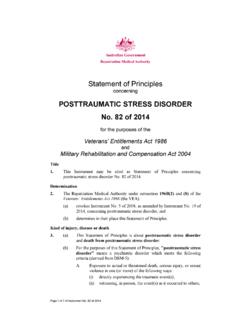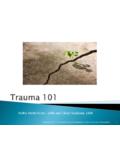Transcription of BY ORDER OF THE SECRETARY OF THE AIR FORCE 17 …
1 BY ORDER OF THE SECRETARY OF THE AIR FORCE AIR FORCE MANUAL 31-201, VOLUME 4 17 NOVEMBER 2011 Certified Current 14 July 2017 Security HIGH-RISK RESPONSE COMPLIANCE WITH THIS PUBLICATION IS MANDATORY ACCESSIBILITY: Publications and forms are available on the e-Publishing website at for downloading or ordering. RELEASABILITY: There are no release restrictions on this publication. OPR: AFSFC/SFOP Supersedes: AFMAN 31-201V4, 20 Mar 2002; AFMAN 31-201V6, 17 May 2002 Certified by: AF/A7S (John A. Fedrigo, SES) Pages: 79 This manual implements AFPD 31-2, Air Provost Operations. This Manual sets forth guidance regarding Security Forces (SF) standards and procedures of Air FORCE civilian and military personnel, including the Air FORCE Reserve and Air National Guard serving in SF roles. It applies to military, civilian and contract personnel as well as military personnel from other US military branches assigned or attached to Air FORCE units.
2 This includes Air FORCE Reserve and Air National Guard units. Violations may result in administrative disciplinary action without regard to otherwise applicable criminal or civil sanctions for violations of related laws. This manual includes material developed by the Critical Incident Response Group, Federal Bureau of Investigations National Academy, Quantico, Virginia and is used with their permission. Records Disposition: Ensure that all records created as a result of processes prescribed in this publication are maintained in accordance with AFMAN 33-363, Management of Records, and disposed of in accordance with the Air FORCE Records Disposition Schedule (RDS) located at Refer recommended changes and conflicts between this and other publications to HQ AFSFC/SFOP, 1517 Billy Mitchell Blvd, Bldg 954, Lackland AFB, TX, 78236, on the AF Form 847, Recommendation for Change of Publication.
3 Field activities are not required to send implementing publications to the higher headquarters functional OPR for review and coordination before publishing. The use of any manufacturer name, trademark, commercial product, commodity, or service within this publication does not imply endorsement by the Air FORCE . 2 AFMAN31-201V4 17 NOVEMBER 2011 SUMMARY OF CHANGES This document is substantially revised and must be completely reviewed. Information from the previous AFMAN 31-201, Volume 6, Civil Disturbance, 17 May 2002, has been incorporated into this document. This document integrates Public Law 93-366, Homeland Security Presidential Directive 5 (HSPD-5), Management of Domestic Incidents, and enables the National Response Framework in the United States Air FORCE .
4 Countering Threats (Chapter 2) has been included and incorporates Active Shooter, Workplace Violence, and School Violence response; Crisis Negotiation has been added (Chapter 5); Civil Disturbance has been added (Chapter 8); Attachments 2, 3, 5 and 6 have been added. Chapter 1 SECURITY FORCES ROLE IN EMERGENCY MANAGEMENT RESPONSE 5 Planning.. 5 Responsibilities.. 7 Phases of Incident Management.. 10 Security Forces Response.. 10 Special Considerations for Response to HAZMAT or CBRNE incidents.. 12 Special Considerations for Criminal or Terrorist Use of CBRNE.. 13 Exercises.. 14 Legal Considerations.. 14 Chapter 2 COUNTERING THREATS 15 Definitions.. 15 Prevention.. 15 Reporting.. 16 Workplace Violence.. 16 School Violence.. 17 Active Shooter.. 19 Chapter 3 BARRICADED SUBJECTS 24 Initial Response.
5 24 Containment of the Scene.. 24 Establishing Jurisdiction and Command and Control.. 25 Negotiations.. 25 Chapter 4 DOMESTIC VIOLENCE AND ABUSE RESPONSE 26 Domestic Violence.. 26 Security Forces Role in Domestic Violence.. 26 AFMAN31-201V4 17 NOVEMBER 2011 3 Unit Commander s Role in Domestic Violence.. 27 Family Advocacy Officer s Role in Domestic Violence.. 27 BDOC/ECC Controller s Role in Domestic Violence.. 27 Patrol Response.. 27 Differentiating Types of Disputes.. 30 Conducting the Interview.. 31 Security Forces Actions.. 31 Chapter 5 CRISIS NEGOTIATION 33 Overview.. 33 Types of Behavior.. 33 Types of Hostage Takers.. 33 Reasoning Behind the Taking of Hostages.. 33 Types of Situations.. 34 High Risk Indicators.. 34 Philosophy of Crisis Negotiation.. 34 Response.
6 35 Operations Section Chief.. 36 Use of Tactical Teams.. 36 Negotiation Teams.. 36 Selecting Team Members.. 37 Training Negotiation Teams.. 38 Resiliency.. 39 First Responder Negotiations.. 39 Guidelines.. 40 Suicide Intervention.. 41 Training.. 43 Chapter 6 EMERGENCY SERVICES TEAM (EST) 44 Concept.. 44 Objective.. 45 Capability.. 45 Organization.. 45 Employment.. 46 Weapons.. 46 4 AFMAN31-201V4 17 NOVEMBER 2011 EST Training and Team Certification.. 47 EST Relationship with CNT.. 48 MWD Team Use.. 49 Emergency Medical Readiness.. 49 Information.. 49 Interagency Cooperation.. 49 Exercises.. 49 Reporting Requirements.. 49 Chapter 7 CIVIL DISTURBANCES 50 Introduction.. 50 Definition.. 50 Federal Intervention and Aid.. 50 Roles of the States.
7 51 Presidential Powers.. 51 Causes.. 51 Locations.. 52 Role of Military Forces.. 52 Levels of Disturbances.. 53 The Participants .. 54 Control FORCE Social Factors.. 55 Crowd Tactics.. 55 Civil Disturbance Training.. 57 Information Needs.. 59 Threat Analysis.. 59 Operations .. 60 Attachment 1 GLOSSARY OF REFERENCES AND SUPPORTING INFORMATION 64 Attachment 2 CATEGORIES OF SUSPICIOUS ACTIVITY 70 Attachment 3 BEHAVIORAL THREAT INDICATORS 72 Attachment 4 SAMPLE MOA 77 Attachment 5 POSSIBLE SITUATIONS REGARDING ENFORCEMENT OF ORDER WITHIN OR NEAR AIR FORCE INSTALLATIONS 79 AFMAN31-201V4 17 NOVEMBER 2011 5 Chapter 1 SECURITY FORCES ROLE IN EMERGENCY MANAGEMENT RESPONSE Planning. Security Forces cannot afford to wait until disaster strikes before taking action to protect resources and personnel.
8 Security Forces personnel must be able to initially respond and cope with any situation that might occur. The Comprehensive Emergency Management Plan (CEMP) 10-2, Major Accidents, Natural Disasters, Enemy CBRNE Attacks & Terrorist use of CBRNE, outlines the necessary actions to cope with on and off base emergencies and disasters. Because of the probability that Security Forces will be the first on scene, it is important that Security Forces personnel become familiar with the terms, duties and responsibilities associated with the Air FORCE Incident Management System (AFIMS). AFI 10-2501, Air FORCE Emergency Management (EM) Program Planning and Operations, and the CEMP 10-2 contain specific guidance on the categories of EM planning. Security Forces must coordinate with the Defense FORCE Commander (DFC), EM office, and installation Antiterrorism Officer (ATO) to ensure that the various installation plans are mutually supportive and are consolidated to the greatest degree possible.
9 Plans must be coordinated through all tasked agencies and should be coordinated with all units/agencies on the installation to eliminate redundancies in planning and operational response capability. Special attention must be given to any memoranda of agreement or mutual aid agreements with civil authorities to ensure roles are clearly defined. Personnel and equipment accountability during an incident response is critical and must be addressed in the planning stages. Security Forces will be responsible for personnel accountability at the Entry Control Point (ECP) of an incident site and procedures must be clearly defined in plans. Some additional Security Forces specific planning factors to consider are: Post changes and how they will be conducted to ensure a smooth transition during prolonged incidents.
10 Possible FORCE Protection Condition (FPCON) manning increases. Protection Level (PL) security mission impacts. Identify Personal Protective Equipment (PPE) available and required to continue the mission. Determine if Individual Protective Equipment (IPE) is available on the installation and will it be effective based on the CBRNE/HAZMAT involved. Determine how many Security Forces personnel may be involved and what their equipment requirements are to conduct the mission. Determine what Security Forces vehicles may be involved and if there will be shortages within the unit or installation. Determine if the Logistics Readiness Squadron (LRS) is able to support any additional vehicle requirements. Consider vehicle marking and emergency equipment requirements, if feasible. Military Working Dog (MWD) planning factors: 6 AFMAN31-201V4 17 NOVEMBER 2011 In some CBRNE/HAZMAT incidents, the MWD may succumb to the materials or agents involved.

















